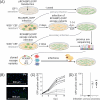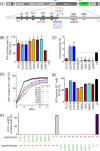Rapid adaptive evolution of avian leukosis virus subgroup J in response to biotechnologically induced host resistance
- PMID: 39146367
- PMCID: PMC11349186
- DOI: 10.1371/journal.ppat.1012468
Rapid adaptive evolution of avian leukosis virus subgroup J in response to biotechnologically induced host resistance
Abstract
Genetic editing of the germline using CRISPR/Cas9 technology has made it possible to alter livestock traits, including the creation of resistance to viral diseases. However, virus adaptability could present a major obstacle in this effort. Recently, chickens resistant to avian leukosis virus subgroup J (ALV-J) were developed by deleting a single amino acid, W38, within the ALV-J receptor NHE1 using CRISPR/Cas9 genome editing. This resistance was confirmed both in vitro and in vivo. In vitro resistance of W38-/- chicken embryonic fibroblasts to all tested ALV-J strains was shown. To investigate the capacity of ALV-J for further adaptation, we used a retrovirus reporter-based assay to select adapted ALV-J variants. We assumed that adaptive mutations overcoming the cellular resistance would occur within the envelope protein. In accordance with this assumption, we isolated and sequenced numerous adapted virus variants and found within their envelope genes eight independent single nucleotide substitutions. To confirm the adaptive capacity of these substitutions, we introduced them into the original retrovirus reporter. All eight variants replicated effectively in W38-/- chicken embryonic fibroblasts in vitro while in vivo, W38-/- chickens were sensitive to tumor induction by two of the variants. Importantly, receptor alleles with more extensive modifications have remained resistant to the virus. These results demonstrate an important strategy in livestock genome engineering towards antivirus resistance and illustrate that cellular resistance induced by minor receptor modifications can be overcome by adapted virus variants. We conclude that more complex editing will be necessary to attain robust resistance.
Copyright: © 2024 Matoušková et al. This is an open access article distributed under the terms of the Creative Commons Attribution License, which permits unrestricted use, distribution, and reproduction in any medium, provided the original author and source are credited.
Conflict of interest statement
The authors have declared that no competing interests exist.
Figures




References
-
- Koslová A, Trefil P, Mucksová J, Krchlíková V, Plachý J, Krijt J, et al.. Knock-Out of Retrovirus Receptor Gene Tva in the Chicken Confers Resistance to Avian Leukosis Virus Subgroups A and K and Affects Cobalamin (Vitamin B12)-Dependent Level of Methylmalonic Acid. Viruses. 2021;13. doi: 10.3390/v13122504 - DOI - PMC - PubMed
MeSH terms
Substances
LinkOut - more resources
Full Text Sources
Miscellaneous

